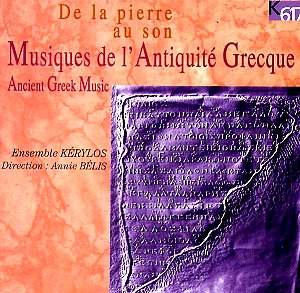Now this
really does come under the heading, 'Early Music': the incisive first
track ('Fanfare') was painted on a vase of the 5th/6th century BC. In
her preface to this recording, Annie Bélis describes the musicological
problems posed by this ancient music. Not the least of these is the
original musical notation used (derived from the Greek alphabet, and
with a theoretical maximum of 1620 signs, and divided into two systems
of notation, one for songs and one for instrumental parts). On top of
this was the rhythmic notation. If it were not for the treatise of Alpius
(3rd century AD), the actual transcription of this music might well
not have been possible.
This is
fascinating, totally mesmeric music. Given the musicological detail
of the booklet, however, it is difficult to fathom why texts and translations
are not included. Still, the experience of travelling so far back in
time is a powerful one: try track 4, the first of the two Delphic Hymns
to Apollo dating from 128BC and unearthed in June 1893 , with its arresting,
percussive opening and its dynamic, unison voices. Many of the trits
are found in the other Delphic Hymn on this recording. Again, the extended
stamp of the percussion, which follows the line of the melody, take
on a moving and inevitable effect.
'Anonymes
de Bellermann,' as they are described in the booklet (Bellermann refers
to the first publisher) comes from an anonymous treatise (pre-5th century
AD). This work is for kithara solo and has a lonely, desolate air about
it . From these chosen examples, it is perhaps possible to get an idea
of the sheer variety of invention this disc presents. 'Seikilos' is
preceded by a French and Greek text which contextualises the other-worldly
wordless soprano of the main body of the song. It is a simple melody,
found engraved on the funereal stela of a certain Seikilos.
Each track
on this disc presents its own delights for the listener.
Interestingly,
the collection ends with a Christian Hymn (3rd century AD), overlapping
the end of Ancient Greek and the beginning of Christian sacred music.
Its slow-moving voices evoke Gregorian chant. It was discovered at Oxyrhynchus
in Egypt.
Notes are
detailed, but readable. The intensity of the performances by the Kérylos
Ensemble only serves to confirm their dedication. Despite
its low total playing time, this issue deserves the highest of recommendations.
Colin Clarke
